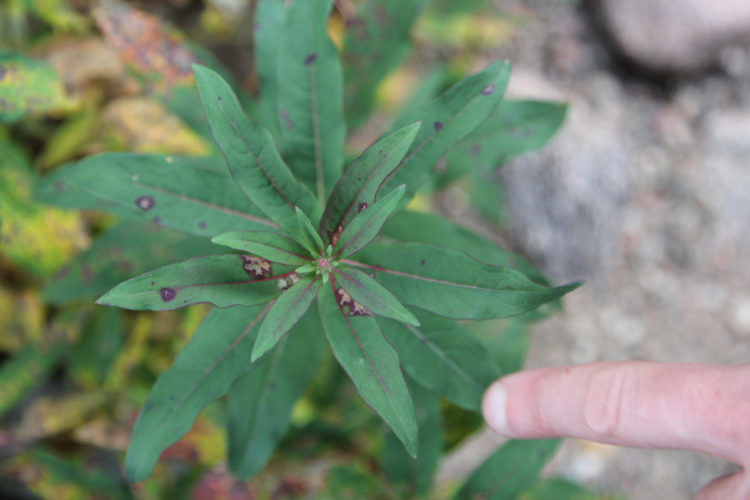
Last week I led my first-ever edible plant ID hike, on North Tenmile Creek Trail in Frisco, Colorado. Here’s a tour of the plants we found in case you’d like to look for them yourself.
Wild Teas
First is fireweed (Epilobium angustifolium, above). It is a native plant but it is often found in disturbed areas. In late summer, it is easily recognized by its pretty pink/purple flowers. In spring, the shoots are edible, and in early summer the new tips work in stir fry, fine-chopped and sautéed, although they are a bit astringent. In fall, the leaves make for a decent, tissue-tightening tea.
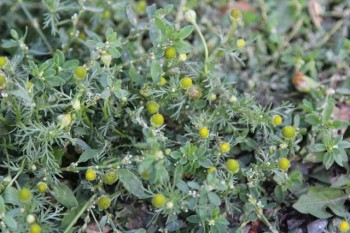
Next is wild chamomile (Matricaria discoidea). This was growing right in the parking lot of the trailhead. Not my choice location for foraging, but it grows all over disturbed areas in Colorado. Crush and smell the flowers, and use the sweet flowers or the whole bitter plant for tea.
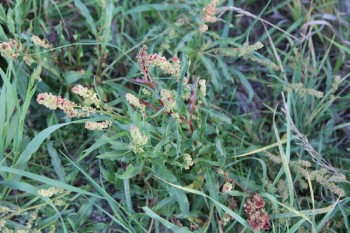
Wild Seeds
Some folks make crackers out of the various dock seeds (Rumex spp.). We found willow dock (R. triangulivalvis syn. R. salicifolius), on the hike. My friend B has been taking dry, rust-red curly dock (Rumex crispus) fruits, toasting them lightly in a pan, crushing and air-winnowing them, crushing them again, and adding them to a cracker recipe. They are a bit astringent, however.
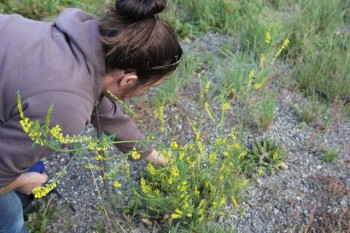
The various docks’ leaves are also edible and yummy when young–whether the new leaves in spring rosettes, or the new leaves that emerge from mature plants in fall under the right conditions. I like to sauté them in olive oil for a lemony, unique green.
In his new Survival Plants textbook, Cattail Bob Seebeck (2012) says you can use sweet clover seeds (Melilotus officinalis, right) to grow edible sprouts. I’m still working on that.
Wild Berries
Originally when I scheduled the hike, I did so in the hopes that we would find plentiful berries; after all, last year was such a good one. Alas, the season did not cooperate!
For example, huckleberries (Vaccinum spp.) abound in the dark forest just off the trail by the creek (wait until you’re 1/4 mile in). However, we found but one berry when we scouted the trail prior to the hike, and that was not for lack of looking. I didn’t think it merited tromping all 17 people through the deep, dark forest on a somewhat sketchy footpath for that, but they’re there; I swear.
Gooseberries and currants (Ribes spp.) too are often plentiful along the creek but again, this year, all we found were a few semi-dry purple currants. Better luck next year, I guess.
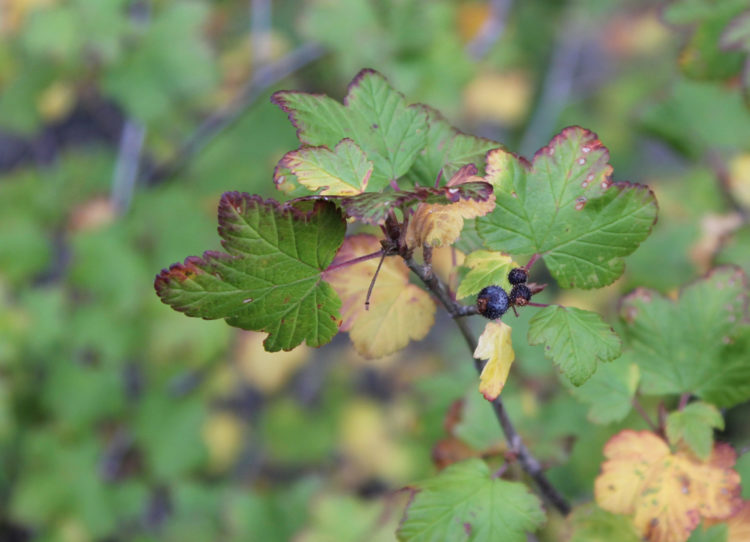
Ribes species are many in these parts, and they all bear edible berries with a small, papery flower sticking out the end of them. Some have spines and some do not; some bear red, sticky berries and some deep purple. The leaves range in size from small to medium but all are palmately lobed like a maple leaf.
I read of folks in Russia using black currant leaves between layers of salted milky cap mushrooms (our local variety is Lactarius deliciosus) for added flavoring. I tried it last year with the leaves of our local trailing black currants (Ribes laxiflorum) and the mushrooms came out pretty good, though I can’t say how much was due to the Ribes.
Anyway, both huckleberries and most of the various Ribes are nice, good for crushing, simmering down, straining, sweetening, and thickening into syrups for various uses. I enjoy sauces of both huckleberries and Ribes atop ice cream or as an ingredient with garlic, oil, and ginger for interesting homemade salad dressings.
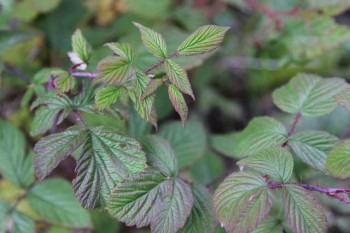
Raspberries abound on North Tenmile Creek Trail too, but there weren’t any left by the time I took my hike out. Still, that’s no reason not to study the leaves and learn the plant. It makes it a cinch to find good berries the following season, provided you spend enough time on trail to catch the season right once you know what you’re looking for.
Last week we also found a small handful of Oregon grapes (Mahonia repens) still dangling beneath their low-lying, holly-like leaves. Many of the leaves have started turning bright red now, so between that and the fact that they have prickers on the leaf points and look like holly, they should be identifiable, berries or no berries. If berries, they are often powder-blue unless they’ve been rubbed a deep purple. Last year we found a good quantity of them and made–you guessed it–sauce!
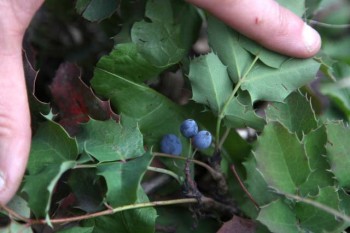
My absolute favorite use for the Oregon grape sauce was to flavor Gregg’s homemade kombucha. The high country’s low-lying Oregon grape has a much taller, often plentiful-berry-bearing relative that grows throughout the Denver metro area, also with edible berries.
This season, one of the plants that keeps amazing me is wild rose (Rosa sp.). They’re so fruitful, red, and lush this year, plump with slightly translucent skin–all good signs of a ripe, slightly sweet treat packed with Vitamin C. I like to gnaw the flesh off the whole rose hip with my teeth, getting all sorts of orange stuff in my gums. It’s good goo, great for a dry mouth and healthy too.
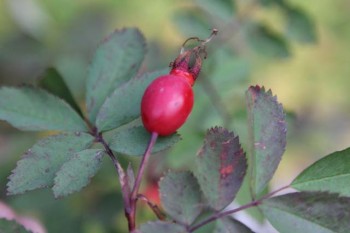
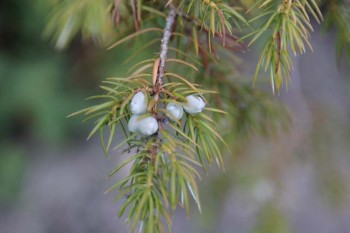
Wild Spice
Creeping juniper (Juniperus communis) is always good for flavoring gin, drying and making meat rubs, or using to flavor sauerkraut, among other uses. The “berries”–which are not really berries at all but actually cones–pictured here are not ripe. The ones you’d want to go for are deep blue.
Ripe juniper berries are used for a spice, not a side dish. Warning: Tasting juniper berries on the trail can leave a long-lasting flavor on the tongue that some might not find altogether pleasant.
Below is another berry that’s not always that fun to eat: kinnikinnik (Arctostaphylos uva ursi, below). The berries, though supposedly packed with Vitamin C, are dry, likened by one author to a mealy apple. I’ve cooked them down but made nothing of merit with them to date. Still, I snack on them when I hike. If you suck on the outside without breaking the skin, they’re mildly sweet.
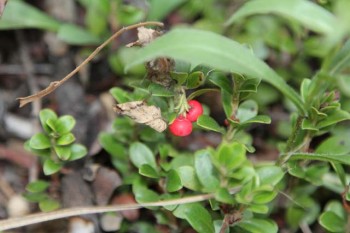
Just Smoke It
Some Native peoples dried the leaves of kinnikinnik to use as part of a smoking mixture with red osier dogwood. We tried smoking some on its own. The smoke was mildly relaxing and seemed not to do us any harm, except for any harm that the act of smoking itself does, of course.
Delightful Dandies
Okay, last but not least, let me present my dear friend dandelion. I plead: despise not the dandelion (Taraxacum officinale). Eat her sweet and pretty yellow flowers, or ferment them for homemade dandelion wine. Take whole dandelions from friends after they weed their gardens, because you can eat every part. Young roots can be cleaned and chopped into small nut-like chunks and eaten raw in salads, and older ones roasted for “dandelion coffee,” a healthful caffeine-free coffee substitute that tastes better than the real deal. And let’s not forget the greens–the greens which, though bitter, can be chopped fine and added to cold, marinated salads or prepared in umteen other ways, all with good-for-you results, even if the taste may take some getting used to. Dandy greens are least bitter prior to flowering. I like to dry the mature leaves for a winter tea too.
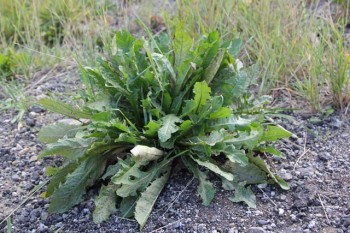
Gregg took this picture because he though the dandelion looked like a head of lettuce. Granted, 10 dogs probably peed on this particular specimen, which is past its prime with leaf mold to boot. I like finding my fall dandy greens under willows off the beaten path along old mining roads in the high country, looking for the greenest, cleanest leaves.
There are many more edible wild plants along the trail; these are just 11 of them. Get out and hike! Happy nibbling!
Updated 3.2.21

Leave a Reply